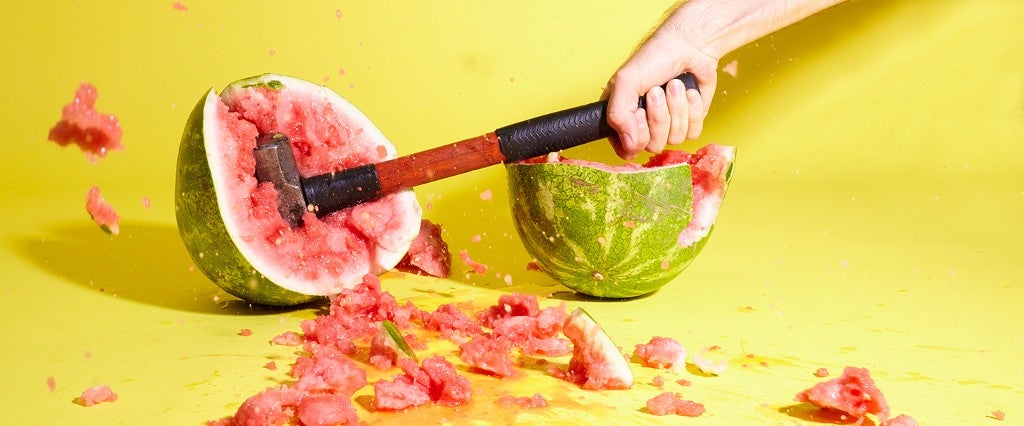What is it about watermelon that bewitches us so? What makes this summer perennial so quintessentially American? Why has it, like bacon, transcended mere food status to become iconic?
The answer begins, of course, with taste. Watermelon is goddamn delicious, a mouth-watering, beyond-sugary culinary bomb redolent of summer afternoons and picnics and smiling children and everything else that is good in this world. But watermelon has so many other distinctive elements beyond its overwhelming deliciousness. There is something wonderfully democratizing about eating watermelon. Give a 1930s dinner party full of aristocrats in tuxedos and duchesses in ball gowns a few platters of watermelon slabs to consume, and they instantly devolve into a slurping, sticky, sweaty mess. It’s simply impossible to exude dignity while eating a big piece of watermelon.
Oh, sure, the aristocrats have their tricks. The melon baller was created to remove watermelon from its messy, organic, watery, sugary original context and reimagine it in a safe, familiar, containable sphere, yet its culinary anarchism remains strong. Stick it in a fruit salad if you must, but it retains its messy distinctiveness, its stubborn unwillingness to conform.
And then there are the seeds, those weird black pellets of squandered future potential that angrily demand to be addressed. Do you spit the watermelon seeds out, and in the process make a spectacularly undignified and messy process even more undignified and messy? Or do you adopt the equally unpalatable strategy of swallowing these seeds and hope that a watermelon patch does not subsequently sprout in your stomach?
Watermelon almost qualifies as a novelty food. It’s as if when God was spitballing ideas for this crazy taste sensation, He was aiming for something that had the general vibe and messiness of chewing tobacco, but was actually healthy.
If watermelon connects us to the earth, it’s also strangely extraterrestrial in appearance and texture. The malevolent, killer talking plant in Little Shop of Horrors is most overtly modeled on the Venus flytrap, but it bears an unmistakable resemblance to a watermelon with a mouth — razor-sharp teeth, an intense hatred of human beings and a body count as well.
On the vine, watermelons look like the pods that spawn sinister doubles in the various incarnations of The Invasion of the Body Snatchers. There’s something oddly ominous about watermelons, something sinister about their construction. Watermelons seem too large to emerge out of the ground, and yet they exist all the same, big, bold and unapologetic.
Watermelon is the proletariat of fruits. If the fruit world were a black-and-white comedy, all the other, lesser, smaller, more reserved melons would be Margaret Dumont and the irascible watermelon would be a cigar-smoking, eyebrows-waggling Groucho Marx perpetually giving her the business and antagonizing the squares.
Historically, watermelon is the food of the underclass, the rural, the poor, the people society doesn’t value. Its derivative products are even more incontrovertibly linked to poverty. I’m thinking of watermelon wine, specifically — simultaneously an insult to watermelon, wine and anyone foolish enough to think combining the two is a good idea — and watermelon gum, of the sickeningly sweet taste and oddly nauseating smell.
Watermelon serves other lowbrow functions as well. Punch a hole somewhere in the magical fruit, pour liquor in said hole and voila!, a fiendishly effective vehicle for disseminating large amounts of alcohol quickly and painlessly, particularly to teenagers and rednecks. Cheap, plentiful and enough for the whole family to share.
In Tom T. Hall’s “(Old Dogs, Children and) Watermelon Wine,” the protagonist encounters an older, black janitor cleaning up a bar, and because this is a Tom T. Hall story song, the janitor decides to favor the protagonist with some unsolicited homespun philosophy regarding the only three things in the world worth “a solitary dime.” Those three exceptions to the universe’s unrelentingly awfulness were, of course, the three favorites of the title. Let the rich people have their diamonds and furs. Watermelon is one of life’s consolation prizes for the struggling.
A 2014 Atlantic article explored how watermelon became a racist trope after the Civil War. “Free black people grew, ate, and sold watermelons, and in doing so, made the fruit a symbol of their freedom.” Racist white America had to undermine it, to transform something as neutral and universal as enjoying food into a mark of cultural and intellectual inferiority.
No fruit is as explosive from a political and racial point of view as the watermelon. For that matter, no fruit is as literally explosive as the watermelon, either, as noted racist Gallagher discovered early in his career with a routine called the “Sledge-O-Matic” that climaxed with the reviled comedian taking a giant mallet to a watermelon. The guts sprayed out over the crowd at shows and unfortunately made his career.
Watermelon is like the human head: a hard outer shell to protect us from a cruel world and a softer, mushier red interior. I consequently suspect that part of the reason people might theoretically “enjoy” a Gallagher performance these days is (and I cannot stress how loosely I am employing the phrases “might” and “enjoy”) is that watching the aged melon-masher destroy fruit in an ostensibly humorous manner can’t help but evoke wish-fulfillment fantasies of the audience being able to wield a giant mallet like Thor’s hammer and use it to shatter Gallagher’s own bigotry-poisoned melon.
But the watermelon is bigger than Gallagher, metaphorically speaking, and the watermelon will not only witness Gallagher’s long-overdue death; it will cackle maniacally at his passing.
So here’s to you, noble watermelon. You really are a whole weird proletariat world wrapped up in one, weird, wonderful food. And you taste good, too.
